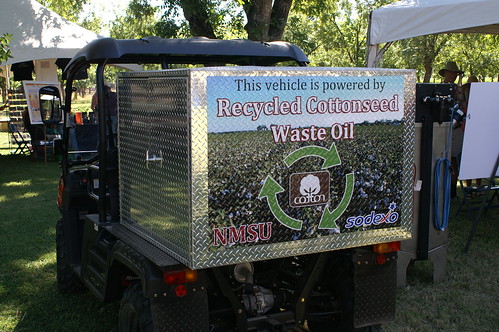
Glandless cottonseed is being used to demonstrate that the elimination of gossypol provides an opportunity to produce high value foods for humans as well as animals. The oil will be used to fry food in a college cafeteria. The used oil will be taken back to the experiment station where it will be converted into biodiesel and used to run the station’s irrigation pumps. The protein, which was also squeezed out during the crushing process, will be used to feed shrimp in an aquaculture experiment and ultimately sold. Photo courtesy of the Cotton Board.
This post is part of the Science Tuesday feature series on the USDA blog. Check back each week as we showcase stories and news from USDA’s rich science and research portfolio.
In the agriculture industry, having a green thumb can help businesses improve their yield and their bottom line. As good stewards, our nation’s farmers, ranchers, and agricultural business are also committed to another type of green. Through sustainable and conservation practices, ag businesses are finding multiple uses for products, which reduces land and water usage.
The USDA’s Agricultural Marketing Service (AMS) witnesses these efforts first-hand while overseeing industry Research and Promotion Programs. These self-help programs that are requested for and completely funded by the industry are charged with developing cutting-edge marketing campaigns and supporting nutrition research that benefits all of the industry’s members. Many of their research projects focus on sustainable practices and conservation. While we know that the list of these types of projects is endless, we would like to highlight a few of the things that the cotton industry is doing.
The multi-faceted cotton plant produces much more than just nature’s most demanded fiber. High quality cottonseed and cottonseed cooking oil is used in many popular snack foods and the plant’s residue (gin byproduct), left after ginning, is used for everything from fertilizer for your flower beds to hydromulch that encourages grass growth while preventing soil erosion. While cottonseed and cottonseed cooking oil are edible products, they are only edible after reducing gossypol levels. A compound found naturally in cotton that detests pests from eating cotton plants, gossypol is toxic for non-ruminant animals while some ruminant animals can resist it.
Since 1993, Cotton Incorporated, the marketing group used to support the Cotton Research and Promotion Program, has funded research to eliminate gossypol in cottonseed. Evolving research by Texas A&M researcher Dr. Keerti Rathore recently suggested the ability to successfully use a powerful gene-silencing mechanism developed for cancer research – Ribonucleic Acid Interference (RNAi) – to reduce the gossypol level in cottonseed while allowing it to be retained in the plant as a natural pest deterrent.
“This groundbreaking news positioned cottonseed for expansion into the food market, said Dr. Kater Hake, Vice-President of Agricultural and Environmental Research at Cotton Incorporated. “We are more than excited that this advancement holds the potential to open up new and varied food and feed markets – which should ultimately increase the value of cottonseed.”
The successful use of RNAi technology has led to a field of glandless cotton being grown in New Mexico, which will be ginned by the USDA gin lab in Las Cruces. The glandless whole cottonseed will be taken to the New Mexico State University (NMSU) where a pilot plant crushing facility is being built.
“Glandless cottonseed is being used to demonstrate that the elimination of gossypol provides an opportunity to produce high value foods for humans as well as animals,” said Tom Wedegaertner, Director of Cottonseed Research & Marketing at Cotton Incorporated. “The oil will then be refined further into cooking oil to be used to fry food in the cafeteria at NMSU. The used oil will be taken back to the experiment station where it will be converted into biodiesel and used to run the station’s irrigation pumps. This is a strong message about the industry’s commitment to sustainability,” adds Wedegaertner.
The research project will continue when the protein, which was also squeezed out during the crushing process, will be used to feed shrimp in an aquaculture experiment already underway at NMSU. “The shrimp will be harvested and sold to NMSU students who eat at the on-campus cafeteria,” explains Dr. Tracey Carrillo, Assistant Director of Campus Farms at the NMSU Ag Experiment Station. Carrillo is hoping to showcase some of the shrimp during a “Shrimp Feast” for NMSU Department Heads and other faculty.
All of us here at AMS are committed to creating opportunities for our nation’s farmers and ranchers. We commend Cotton Incorporated and the rest of the cotton industry for their commitment to sustainable practices.
No comments:
Post a Comment
Note: Only a member of this blog may post a comment.